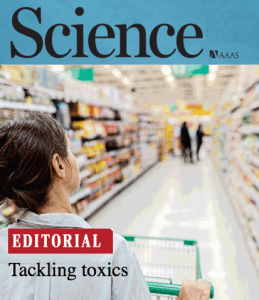April 2016: Celebrating Ten Years of "Tackling Toxics"
In this edition:
- What to do with a Flame-Retarded Couch?
- Tris in my Tent?
- Switch in Cosmetics Leads to Fast Drop in Teen Girls’ Chemical Exposure
- Antimicrobials in Health Care Furnishings?
- Boston Changes Fire Code to Allow Flame Retardant-Free Furniture in Public Spaces

Ten years ago I attended the spring 2006 California Chemical Policy Symposium. At that time, I had not been doing scientific research for 26 years and hoped for any chance to contribute to science. I’d have been happy to wash test tubes in a lab!
I learned that the harmful flame retardant chlorinated tris, which my research had helped remove from children’s pajamas in the 1970s, was back–in the nation’s furniture–and began the work that led to my founding the Green Science Policy Institute. Since then we have had the extraordinary opportunity to work with leading scientists, NGOs, government and businesses to reduce the use of flame retardants and other harmful chemicals. This has been the greatest adventure of my life, even more challenging and rewarding than leading the first American ascent of Annapurna.
You can learn more about our work on Tackling Toxics by joining my American Chemical Society webinar this Thursday, April 21, at 11am Pacific time. Please register here.
As we celebrate our first decade, our media coverage continues to be strong. Most remarkable is the honor of writing an editorial “Tackling Toxics ” for Science, which is considered the world’s leading outlet for scientific news. Other coverage includes Gwyneth Paltrow’s consumer e-newsletter Goop which features an interview with me on fluorinated chemicals, and an interview on Rose Aguilar’s Your Call Radio, “Toxic chemicals lurking in your home.”
Over the next decade we will keep on climbing towards the summit of healthier and safer products for our planet, population, and, most important, future generations.
Happy Spring!
Arlene and the Green Science Team
What to do with a Flame-Retarded Couch?

When we buy new furniture without harmful flame retardants, the question remains of what to do with the old couch. Hauling it to a thrift store just passes the toxic chemical problem on–most often to students and low-income families.
On April 12-13th, we organized a symposium in Berkeley on how to responsibly manage end-of-life for foams and plastics mixed with flame retardants. Our 40+ enthusiastic participants included scientists, NGOs, trade associations and waste management professionals, people who normally never cross paths, but were pleased to find common ground. Outcomes include proposals for peer-reviewed papers and proposed partnerships between industry and academia for research projects on promising technologies. We thank the National Science Foundation and the National Institute of Environmental Health Sciences for supporting this symposium.
Stay tuned for our report, which will include promising next steps for solving this important problem. Please contact [email protected] to learn more.
Disposal of products containing toxic chemicals is a tough but important challenge and we are happy to be getting the ball rolling. Turning off the tap on persistent harmful chemicals is the best solution in the long-term and our Six Classes work is doing that.
Tris in my Tent?

Researchers at Duke University found that people can be exposed to flame retardants from the set-up and use of backpacking tents, which are often treated with flame retardants to comply with a flammability standard called CPAI-84. This standard is required in seven U.S. states, and many manufacturers sell flame retarded tents throughout the U.S. to comply. This is similar to the case of upholstered furniture, where furniture sold in the U.S. and Canada contained flame retardants to meet California’s flammability regulations.
TDCPP, the same form of chlorinated tris that was removed from baby pajamas in the 1970s, was the most frequently detected flame retardant in the tents studied. The researchers found that levels of flame retardants on people’s hands increased after tent set-up. Also flame retardants were measured in the air inside tents. Disturbing to go into the great outdoors, only to be exposed to tris.
Switch in Cosmetics Leads to Fast Drop in Teen Girls’ Chemical Exposure

Teenaged girls are among the heaviest users of personal care products. In a UC Berkeley study 100 Latina teenaged girls switched to personal care products without three endocrine disrupting chemicals.
After three days, their urine tests showed remarkable decreases in the levels of these chemicals:
- 35% decrease in triclosan, an antimicrobial chemical that has been linked to the disruption of thyroid and reproductive hormones
- 27% decrease in phthalates, plasticizers commonly used in some nail polish and fragrance
- 44% decrease in some parabens, used as preservatives in personal care products
This study shows that using less harmful products can have an immediate impact in decreasing our body levels of problematic chemicals.
Antimicrobials in Health Care Furnishings?

Health Care without Harm has released a review questioning the use of antimicrobials in health care settings. As summarized in this paper, “…triclosan has not been shown to be effective in a number of applications as an antimicrobial in consumer products, can increase the risk of more generalized antibiotic resistance, and can have adverse health effects…”
Boston Changes Fire Code to Allow Flame Retardant-Free Furniture in Public Spaces

Great news! On March 23, 2016, Boston’s city council unanimously passed an ordinance to allow furniture without flame retardant chemicals in public buildings with sprinkler systems. This is big news because Boston was the only big city in the U.S. that required furniture with high levels of flame retardants in sprinklered buildings.
Receive Updates By Email
Subscribe to our monthly newsletter and get these updates delivered right to your inbox!